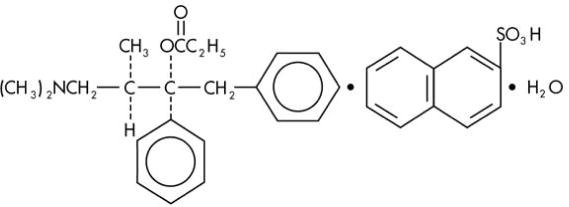Darvon-N
Generic name: propoxyphene napsylate
Dosage form: tablet, film coated
On This Page
Darvon-N Description
Darvon-N contains propoxyphene napsylate, USP which is an odorless, white crystalline powder with a bitter taste. It is very slightly soluble in water and soluble in methanol, ethanol, chloroform, and acetone. Chemically, it is (αS,1R)-α-[2-(Dimethylamino)-1-methylethyl]-α-phenylphenethyl propionate compound with 2-naphthalenesulfonic acid (1:1) monohydrate, which can be represented by the accompanying structural formula. Its molecular weight is 565.72

Propoxyphene napsylate differs from propoxyphene hydrochloride in that it allows more stable liquid dosage forms and tablet formulations. Because of differences in molecular weight, a dose of 100 mg (176.8 μmol) of propoxyphene napsylate is required to supply an amount of propoxyphene equivalent to that present in 65 mg (172.9 μmol) of propoxyphene hydrochloride.
Each tablet of Darvon-N contains 100 mg (176.8 μmol) propoxyphene napsylate. The tablet also contains cellulose, cornstarch, iron oxides, lactose, magnesium stearate, silicon dioxide, stearic acid, and titanium dioxide.
Darvon-N - Clinical Pharmacology
PharmacologyPropoxyphene is a centrally acting opiate analgesic. In vitro studies demonstrated propoxyphene and the metabolite norpropoxyphene inhibit sodium channels (local anesthetic effect) with norpropoxyphene being approximately 2-fold more potent than propoxyphene and propoxyphene approximately 10-fold more potent than lidocaine. Propoxyphene and norpropoxyphene inhibit the voltage-gated potassium current carried by cardiac rapidly activating delayed rectifier (hERG) channels with approximately equal potency. It is unclear if the effects on ion channels occur within therapeutic dose range.
Pharmacokinetics AbsorptionPeak plasma concentrations of propoxyphene are reached in 2 to 2.5 h. After a 65-mg oral dose of propoxyphene hydrochloride, peak plasma levels of 0.05 to 0.1 μg/mL for propoxyphene and 0.1 to 0.2 μg/mL for norpropoxyphene (major metabolite) are achieved. Repeated doses of propoxyphene at 6 h intervals lead to increasing plasma concentrations, with a plateau after the ninth dose at 48 h. Propoxyphene has a half-life of 6 to 12 h, whereas that of norpropoxyphene is 30 to 36 h.
DistributionPropoxyphene is about 80% bound to proteins and has a



